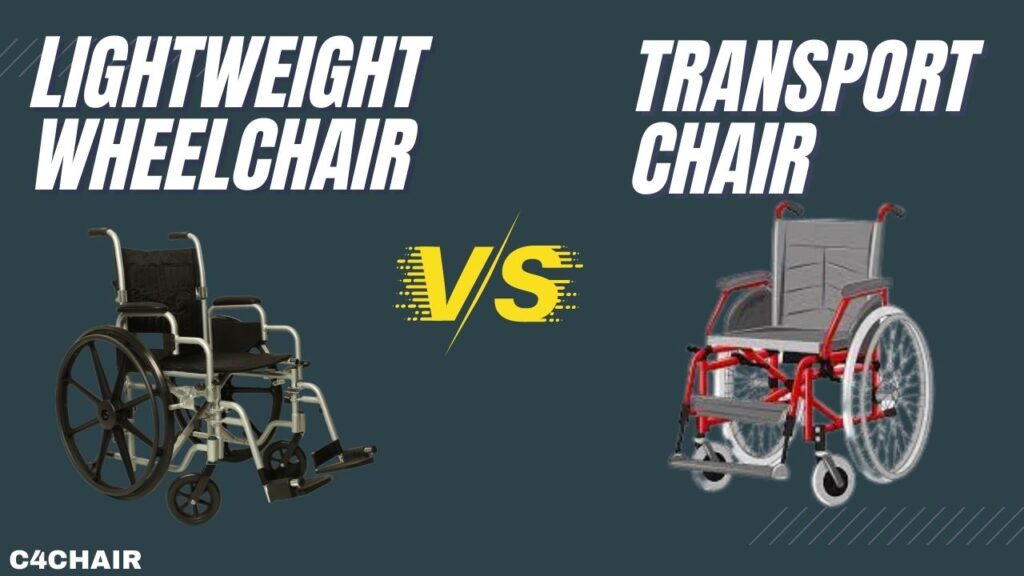If you consider a lightweight wheelchair the other name of a transport chair, then this context will change your mindset. Because both are different categories but normally mistaken as one. The basic design of both kinds is very similar. Also, these two groups help the elderly or disabled to avail independence and enjoy an active lifestyle. But still, there are a few key differences. Being a US Citizen, it’s good to learn how lightweight wheelchair vs transport chair. Because in the United States, a huge number of elderly above 65 age become dependent on a mobility device.
So, the answer to the question is that a standard wheelchair comprises larger rear wheels. Whereas, you’ll come across the transport wheelchairs with small rear wheels. The reason behind this difference is that standard lightweight wheelchairs are made for self-propelling. On the other hand, an attendant is required to maneuver the transport wheelchair and the elderly cannot operate it independently.
Contents
Lightweight Wheelchair vs Transport Chair
A standard wheelchair is made out of sturdier reinforced steel and ensures durability for years to come. However, a transport wheelchair comprises lightweight material, folds compactly, and is easy to store. Similarly, a basic wheelchair comes furnished with a lot of accessories like cup holders, cushions, trays, etc. on the contrary, a transport wheelchair features narrow frameworks for convenient passing through doors and passages.
Difference Between A Lightweight Wheelchair And A Transport Chair:
A lightweight wheelchair is one of the most demanding categories of the wheelchairs. Unlike traditional wheelchairs, it is built out of lightweight material. As a result, maneuvering it becomes super smooth and easy.Are you on a mission to buy a wheelchair? But confused about what you want! A lightweight wheelchair or transport chair. The below guide will put you on a right track.
1. Rear wheels:
First thing first! The size of the back wheels demonstrates that the particular model belongs to which category. If the rear wheels are larger, it means the wheelchair is meant to do something more than just transportation. Larger rear wheels (18”-24”)let the user self-propel the wheelchair. As a result, a caregiver remains no more mandatory with the user. Because the ability to self-propel increases the independence of the elderly.
However, if the rear wheels are smaller (8”-12”), then the model comes under the category of a transport chair. Because a transport chair is not designed to be self-propelled. The smaller size of the back wheels minimizes the weight of the device. Thus, it becomes very easy for the attendant to carry it from one place to another. This reduction in volume also helps in an easy adjustment of the chair in the car’s trunk. Not to forget! The small rear wheels aid in the easy and smooth movement of the chair also.
2. Weight:
How can we forget to mention the weight difference between wheelchair and transport chair? One buys a transport chair solely for transporting the elderly from one place to another. So, it should be lightweight enough to fulfill the purpose. That’s why the transport chairs available in the market weigh as low as 10lbs.
On the contrary, a lightweight manual wheelchair is not lightweight enough. It is not meant for transportation and traveling. Normally its weight range from 32lbs to 38lbs. This weight is considered the minimum in the category of manual wheelchairs. But for traveling purposes, this weight is not suitable to carry.
3. Customizability:
While addressing the difference precisely, let’s highlight that lightweight manual wheelchairs are more customizable in comparison. The user spends sufficient time in a manual wheelchair. He may eat his lunch or dinner while being seated in it. For this purpose, some models offer adjustable armrests so that the chair easily gets set on the dining table.
Whereas, the transport chair is designed for traveling only. The elderly spend a limited span in it. Thus, doesn’t need it to be extravagantly customizable.
4. Braking system:
Both kinds hold a drastic difference in the braking system. Manual lightweight wheelchairs include a push-lock wheel mechanism. This helps the user to lock the chair himself while sitting in or leaving the chair.
However, the scenario is quite different for the transport chairs. Their braking system is available on the handles. As a result, the attendant can easily use the brake. This design allows the caregiver to precisely control the movement of the chair on slopes or different kinds of terrains.
5. Comfortability:
As we mentioned earlier that the user spends the majority time of his day in a manual lightweight wheelchair. So, the manufacturers make them meet standards of comfort. You will find these chairs with padded backrests, armrests, and seats.
The case is not the same for a transport chair. It features a compact design. So that it can easily adjust in the car trunk. The padding adds to the volume. so, this category lacks padded features and is made less bulky.
How To Maneuver A Wheelchair?
when you enter the market, you come across different kinds of wheelchairs. These kinds vary from each other in terms of features. But all categories primarily focus to infuse independence in the elderly and disabled.
You will see electric wheelchairs. An electric motor powers the particular model and helps in propelling without any foreign aid. Controlling the movement of an electric wheelchair is very easy with the help of a joystick. Maneuvering an electric wheelchair is not at all rocket science. They are considered safer to maneuver in comparison to traditional models. But only in comparison. Otherwise, the users of electric wheelchairs have reportedly suffered from multiple accidents.
The causes are inevitable. Sometimes the user loses control while at other times, the wheelchair tips over. These kinds of accidents are very common with wheelchairs irrespective of their kinds.
By avoiding a few silly mistakes, one can easily protect himself from mishappenings. Below you’ll get to know about some instructions for both attendants and caregivers. You’ll precisely learn how to maneuver a wheelchair either you belong to a caregiver or user community.
Guidelines for users:
- Always sit on the wheelchair in an erect position. Make sure that your feet are placed on the footrest.
- Moving a manual wheelchair requires some training from a therapist or medical expert. However, hold wheels and move them back and forth in a particular direction as an initial demo.
- Once you feel your grip over the movement, start heading forward. While moving ahead you will come across corners and turns. Just slow down your speed and you’ll get through them successfully. Don’t dare to take a turn speedily while being in the wheelchair. This kind of hassle may end in irreversible results.
- Additionally, you need to strongly avoid going up on slop or down. Both movements are strictly forbidden if no attendant is there to assist you.
Guidelines for attendants:
- First of all, lock the wheelchair. This is a very important safety measure. Transferring the patient in and out of the chair without locking can be severely dangerous. Also, make sure that the footrests are folded to the sides. So that they don’t interfere in the way.
- Make the patient sit on the chair in a good erect posture.
- Once the patient is seated, the attendant should unfold the footrest. Next, he needs to help the patient keep his feet on the footrest.
- Now grip the handles of the wheelchair available on the backside. Practice pushing and pull it a bit. Once you feel complete control over the movement, start moving it. It is a precautionary step to inform the patient once you are about to move the wheelchair.
- In order to take a turn, just slow down the speed. Taking a quick turn doesn’t give a pleasant feel to the patient. Also never experiment with a new move. As this might be risky and end in a disaster.
- We also recommend attendants to practice maneuvering a wheelchair without a seated patient. This will help them learn some do’s and don’ts before the original experience.
Final Verdict:
A wheelchair is a lifesaver for less mobile elders. It lets them move in the house or outdoors with great confidence. To enjoy the utility of a wheelchair, it is very important to learn how lightweight wheelchair vs transport chair. Also it must be compatible with your needs and requirements. Selecting any category blindly can ruin your hard-earned money. Making a final choice is no piece of cake. Rather it’s quite overwhelming. Because endless options are available in the market. But our buying guide will precisely help you in making a perfect choice. Apart from this, we have also given some guidelines about how to maneuver a wheelchair. So, we hope that you’ve got the majority of your answers. Now you have to play your part and bring the most suitable model to your home. Also, don’t forget to refer this article to your granny. In this way, she’ll also learn some instructions for being the user of a wheelchair.

